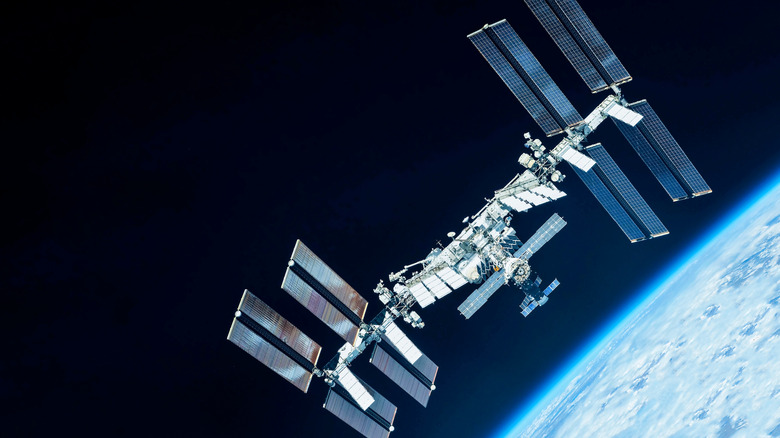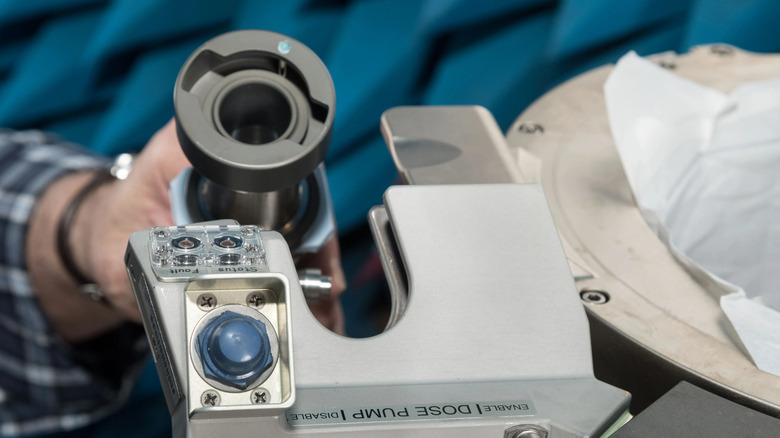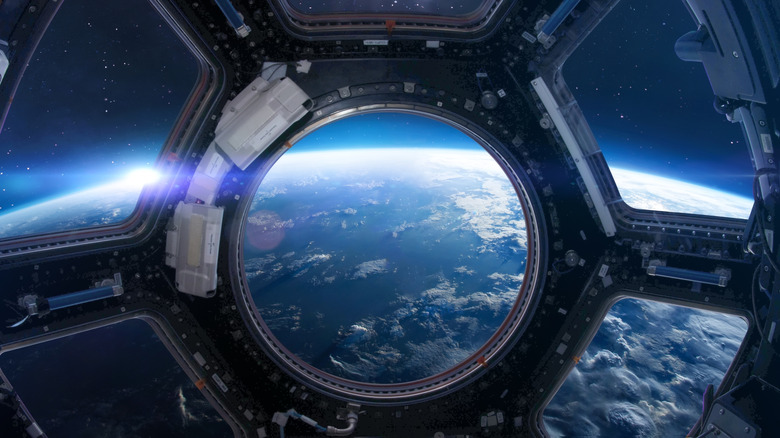Using The Bathroom On The International Space Station Is More Complicated Than You Think
The first U.S. citizen to ever fly in space peed in his space suit. Alan Shepard's May 5, 1961 flight on the Mercury spacecraft Freedom 7 was meant to be a short, 15-minute jaunt through 490 miles of space, but when the expedition's launch was delayed for several hours, Shepard requested to exit the spacecraft to relieve himself. Mission control decided it was better not to waste any more time and granted the astronaut permission to simply go in his suit. He did, short-circuiting the suit's electronic biosensors. Soon after, Shepard ushered in a new era of space travel and exploration in wet shorts.
Humans don't stop being human in space, and even astronauts have to take care of business. The history of developing waste collection systems for spacefarers to relieve themselves is a fascinating, occasionally vulgar, and sometimes hilarious one. But the basic challenge for scientists and engineers has remained the same over the years: how do you go to the bathroom in space without making a mess of everything? It's just one of many details most people don't know about life on the International Space Station (ISS).
The lessons history has taught researchers over the years have come in handy on the ISS. Going to the bathroom in orbit is nothing like the experience you have at home on Earth. For one, it's one of the most delicate daily tasks astronauts face. In the microgravity of space, waste doesn't "fall," which means designing a system to safely and cleanly dispose of it becomes an engineering puzzle. And one of the best answers scientists have come up with to this quandary? Suction. Lots of suction. Here's how it works.
How to go to the bathroom in space
On Earth, gravity takes care of the physics involved in using the toilet. But in microgravity, everything is different, meaning astronauts need help. On the ISS, using the bathroom is a carefully choreographed operation involving foot restraints and hand grips to keep astronauts stable while doing their business.
So how does it work? Well, space toilets utilize air flow to suck urine and fecal matter off and away from the body into containment vessels. Astronauts on the ISS use a specially designed funnel connected to a hose for urine and a device resembling a small circular seat for solids. The seat's compact shape creates optimized contact so that everything that comes out gets funneled away quickly. In 2020, NASA sent up a new $23 million space toilet to the ISS named the Universal Waste Management System (UWMS), which incorporated years of feedback from astronauts to make it more effective and comfortable. For example, the previous ISS toilet had incorporated thigh straps to keep astronauts in place while going to the bathroom, but these were removed because they were too limiting to allow individuals to arrange themselves as comfortably as they wanted.
The UWMS toilet is a compact marvel, standing at around 28 inches in height and incorporating a waste compactor that astronauts hand their deposits over to (their fecal waste gets channeled into a small bag, which they then have to seal and push into the proper receptacle for storage). When the receptacle fills up — it can only hold around 30 deposits of material — it gets jettisoned into space, and burns up in the atmosphere. So, the next time you wish on a shooting star, you might just be wishing on a flaming bag of astronaut feces.
Recycling waste in space
On the ISS, no drop goes to waste — quite literally. While solid waste is sealed and ejected to burn up in the atmosphere, urine is recycled through a sophisticated water recovery system. "We recycle about 90% of all water-based liquids on the space station, including urine and sweat," astronaut Jessica Meir, told NASA. "What we try to do aboard the space station is mimic elements of Earth's natural water cycle to reclaim water from the air. And when it comes to our urine on ISS, today's coffee is tomorrow's coffee!"
While that might be an unfamiliar or unsettling thought to non-astronauts, it's a perfectly functioning way to keep things sustainable in the environment of space. The system works by filtering and distilling water vapor from urine, then purifying it with chemical treatments to remove any contaminants. The result is ultra-clean, potable water. The filtration system is so effective that the resulting water often tests cleaner than what many people drink from Earth's municipal sources.
NASA is continuing to work on improving the efficiency of its water filtration system to at least 98%. Pushing the limits here will be crucial to ensuring that future crewed missions to Mars or other distant cosmic bodies can properly sustain themselves. Space toilets and the systems they're connected to, it turns out, are just as much of an engineering feat as you might have expected. That's probably for the best. If space toilets didn't function properly, the resulting mess would definitely crack our top 5 worst things to ever happen on the ISS.


